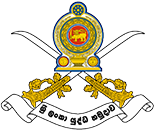His Excellency the President of Uganda, Mr Yoweri Kaguta Museveni, now in Sri Lanka at the invitation of his Sri Lankan counterpart was enlightened about the sequence of military achievements that led to the successful completion of the Wanni humanitarian operations by the Commander of the Army Lieutenant General Jagath Jayasuriya on Wednesday (14) during a special meeting at Hotel Hilton.
The visiting Ugandan President, his entourage, Sri Lanka’s Minister of External Affairs, Prof. G.L Peiris and a few senior military officers were associated with the occasion.
Lieutenant General Jagath Jayasuriya, who was also the Commander, Security Forces Headquarters - Wanni (SFHQ-W) commanding 64 Divisions, Brigades and Units during the time of humanitarian operations, in his presentation to the visiting dignitary explained how the humanitarian operations began with two main phases; Eastern Theatre (phase 1) and Northern Theatre (phase 2).
During July 23, 2006 - April 25, 2007, the operations under the phase 1 was able to liberate the entire East while the phase 2 commenced on 26 February 2007 successfully came to an end on 19 May 2009 liberating the entire island, the Commander said.
The phase 1 focusing axes of formations in the Eastern theatre continued with the battle splitting into 9 sub phases resulting in the liberation of approximately 6000 sq km as the phase 1 reached its culmination. Explaining the onset of the Wanni humanitarian operations afterwards, giving exact locations of the then Forward Defence Line, held by the Security Forces in the Wanni, the Commander told them that how the ground realities made them to raise Divisions in order to further expand the multi-pronged approach against resisting forces.
In the northern theatre, during the phase 1, the Security Forces succeeded in liberating an area of 7753 sq km, capturing a record haul of LTTE explosive devices, weapons and warlike items, he added.
Even after three and half years of the final battles against the LTTE, artillery gun barrels that had been buried in the No Fire Zone in Wellamullivaikkal were uncovered, the Commander quipped. As per rescue of civilians, we had a series of challenges, the Commander said, talking about challenges that cropped up as the humanitarian operations were underway.
He said that though the LTTE tried to prevent the exodus of civilians who were used as human shields, civilians in their thousands crossed over the lagoon and sought protection under the Security Forces as the final stages of the battle were taking a critical phase. In the melee, the LTTE was seen firing and killing civilians trying to leave them. Those who defied were killed while they were trying to flee. As the situation was getting worse, the Army immediately created safe passages and asked civilians to use them and reach the Security Forces for protection. This worked very well and all those who crossed over to the government controlled areas were received with immediate care and attention of Sri Lanka Army. After receiving those fleeing in search of protection, the Army attended to their basic needs and provided immediate medical facilities.
In this way, all those internally displaced civilians on the flee were received and registered while providing temporary shelter and security, the Commander pointed out using slides.
Lieutenant General Jayasuriya touching on the subject of strategies that defeated terrorism said that the unique advantage, enjoyed by the government was the ability to fuse together the sensitive political and the military structures, through the brotherhood of the President and the Secretary of Defence, which synergized the overall effort. Political will as well as diplomacy applied in correct measure was at its peak and economic stability which is very much critical for success of any counter insurgency movement was forthcoming and sound and all these multi-pronged approaches brought about a comprehensive defeat to the LTTE.
At the military level, it was the LTTE military power and external support which sustained the organization. But the centre of gravity of the LTTE during almost three decades of conflict was often misidentified as the leadership, but in fact it was their military machinery and external resources. Blending conventional and counter insurgency principles together the military strategy focused largely on dismantling of the LTTE while denying access to external support.
Achieving a careful balance between attrition and securing of LTTE controlled areas, the troops fixed the LTTE in Jaffna and pursued the clearance and pacification of the East, in order to deny the LTTE the ability to disrupt the clearance of the vital Northern Province.
At the same time, with the support of the Navy, LTTE supplies were cut off and TROOPS isolated the LTTE from getting external support. To coincide with the public concern, a carefully-crafted media and information strategy kept the populace informed of operational success on daily basis and the Army troops relentlessly pursued the campaign until the decisive completion of the final Humanitarian Operation.
Commenting on the post-war situation challenges, the Commander offered the audience with a comprehensive picture of IDP’s resettlement, rehabilitation and troops reintegration of LTTE combatants, efforts on reconciliation, economic revitalization, human rights of rehabilitation and sustainable peace, social cohesion with special emphasis on combatants’ transition to civilian life through a very comprehensive programme to address their ideological, emotional, social, religious, cultural, economic and political needs to transform the most dangerous terrorists to be peace loving, harmonious and responsible members in the society whilst reintegrating them into the social fabric.
In conclusion, the Commander specified instances such as the mass marriage ceremony of former combatants, Army demining roles, civil-military activities and Army initiatives, like the Defence Seminar, Ex-cormorant Strike training, etc.
The visiting Ugandan President, his entourage, Sri Lanka’s Minister of External Affairs, Prof. G.L Peiris and a few senior military officers were associated with the occasion.
Lieutenant General Jagath Jayasuriya, who was also the Commander, Security Forces Headquarters - Wanni (SFHQ-W) commanding 64 Divisions, Brigades and Units during the time of humanitarian operations, in his presentation to the visiting dignitary explained how the humanitarian operations began with two main phases; Eastern Theatre (phase 1) and Northern Theatre (phase 2).
During July 23, 2006 - April 25, 2007, the operations under the phase 1 was able to liberate the entire East while the phase 2 commenced on 26 February 2007 successfully came to an end on 19 May 2009 liberating the entire island, the Commander said.
The phase 1 focusing axes of formations in the Eastern theatre continued with the battle splitting into 9 sub phases resulting in the liberation of approximately 6000 sq km as the phase 1 reached its culmination. Explaining the onset of the Wanni humanitarian operations afterwards, giving exact locations of the then Forward Defence Line, held by the Security Forces in the Wanni, the Commander told them that how the ground realities made them to raise Divisions in order to further expand the multi-pronged approach against resisting forces.
In the northern theatre, during the phase 1, the Security Forces succeeded in liberating an area of 7753 sq km, capturing a record haul of LTTE explosive devices, weapons and warlike items, he added.
Even after three and half years of the final battles against the LTTE, artillery gun barrels that had been buried in the No Fire Zone in Wellamullivaikkal were uncovered, the Commander quipped. As per rescue of civilians, we had a series of challenges, the Commander said, talking about challenges that cropped up as the humanitarian operations were underway.
He said that though the LTTE tried to prevent the exodus of civilians who were used as human shields, civilians in their thousands crossed over the lagoon and sought protection under the Security Forces as the final stages of the battle were taking a critical phase. In the melee, the LTTE was seen firing and killing civilians trying to leave them. Those who defied were killed while they were trying to flee. As the situation was getting worse, the Army immediately created safe passages and asked civilians to use them and reach the Security Forces for protection. This worked very well and all those who crossed over to the government controlled areas were received with immediate care and attention of Sri Lanka Army. After receiving those fleeing in search of protection, the Army attended to their basic needs and provided immediate medical facilities.
In this way, all those internally displaced civilians on the flee were received and registered while providing temporary shelter and security, the Commander pointed out using slides.
Lieutenant General Jayasuriya touching on the subject of strategies that defeated terrorism said that the unique advantage, enjoyed by the government was the ability to fuse together the sensitive political and the military structures, through the brotherhood of the President and the Secretary of Defence, which synergized the overall effort. Political will as well as diplomacy applied in correct measure was at its peak and economic stability which is very much critical for success of any counter insurgency movement was forthcoming and sound and all these multi-pronged approaches brought about a comprehensive defeat to the LTTE.
At the military level, it was the LTTE military power and external support which sustained the organization. But the centre of gravity of the LTTE during almost three decades of conflict was often misidentified as the leadership, but in fact it was their military machinery and external resources. Blending conventional and counter insurgency principles together the military strategy focused largely on dismantling of the LTTE while denying access to external support.
Achieving a careful balance between attrition and securing of LTTE controlled areas, the troops fixed the LTTE in Jaffna and pursued the clearance and pacification of the East, in order to deny the LTTE the ability to disrupt the clearance of the vital Northern Province.
At the same time, with the support of the Navy, LTTE supplies were cut off and TROOPS isolated the LTTE from getting external support. To coincide with the public concern, a carefully-crafted media and information strategy kept the populace informed of operational success on daily basis and the Army troops relentlessly pursued the campaign until the decisive completion of the final Humanitarian Operation.
Commenting on the post-war situation challenges, the Commander offered the audience with a comprehensive picture of IDP’s resettlement, rehabilitation and troops reintegration of LTTE combatants, efforts on reconciliation, economic revitalization, human rights of rehabilitation and sustainable peace, social cohesion with special emphasis on combatants’ transition to civilian life through a very comprehensive programme to address their ideological, emotional, social, religious, cultural, economic and political needs to transform the most dangerous terrorists to be peace loving, harmonious and responsible members in the society whilst reintegrating them into the social fabric.
In conclusion, the Commander specified instances such as the mass marriage ceremony of former combatants, Army demining roles, civil-military activities and Army initiatives, like the Defence Seminar, Ex-cormorant Strike training, etc.
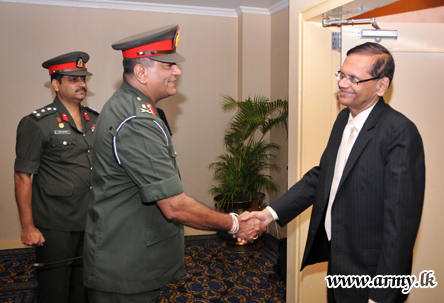 |
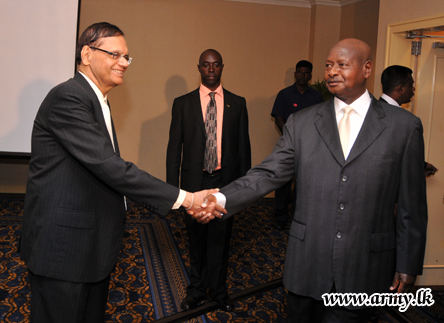 |
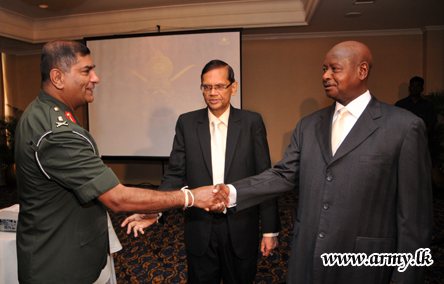 |
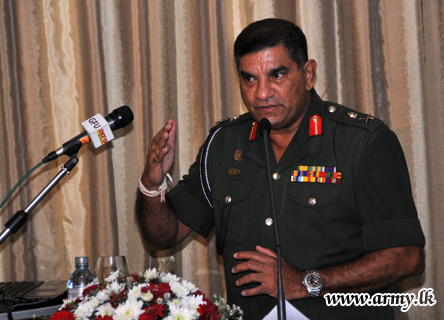 |
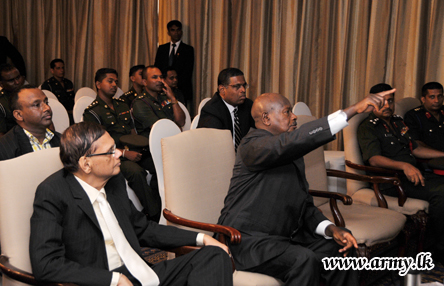 |
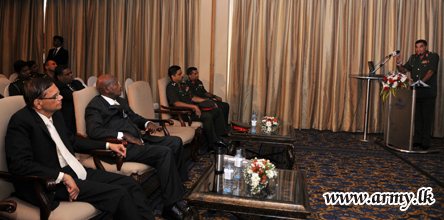 |
 |
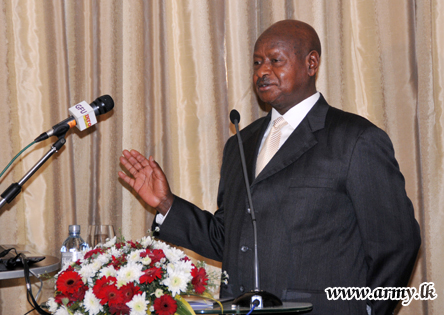 |
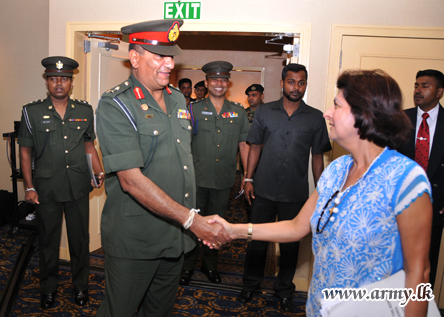 |
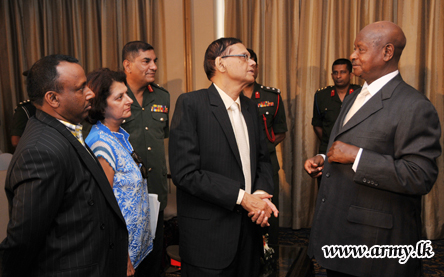 |
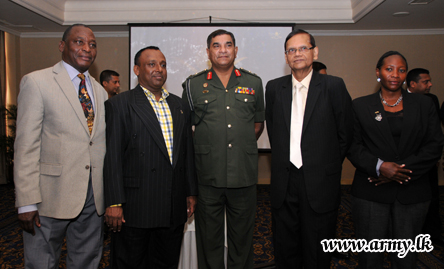 |
